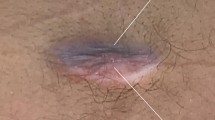Abstract
Object
We report the rare finding of trimyelia with divergent cord pathways in a 33 5/7-week-old fetus who died shortly after spontaneous vaginal delivery.
Methods
The main autopsy findings were three separate and distinct spinal cords, arising from the medulla and exiting through three separate foramina magni. The two lateral cords coursed toward each upper extremity and the medulla split into two halves that rejoined to form a central cervical cord. Further evaluation of this anomaly revealed agenesis of the cerebellar vermis and cystic dilation of the fourth ventricle. Microscopic cross-sections of the two lateral cords demonstrated well-formed central canals, white matter, and central gray with motor neurons. Sections of the abnormal mid-cervical cord demonstrated abnormally structured cord parenchyma without central canals.
Conclusions
Some features were consistent with iniencephaly; however, defects of the occipital bone, anterior spina bifida, and shortening of the spinal cord were absent. Although agenesis of the cerebellar vermis and cystic dilation of the fourth ventricle indicate Dandy–Walker syndrome, other features such as hydrocephalus, agenesis of the corpus callosum, infundibular hamartomas, and malformations of the inferior olives or an occipital encephalocele were absent. The possible pathogenesis of this intriguing pathological entity is briefly discussed.



Similar content being viewed by others
References
Bordarier C, Aicardi J (1990) Dandy–Walker syndrome and agenesis of the cerebellar vermis: diagnostic problems and genetic counseling. Dev Med Child Neurol 32:285–294
Dryden RJ (1980) Duplication of the spinal cord: a discussion of the possible embryogenesis of diplomyelia. Dev Med Child Neurol 22:234–243
Harding B, Copp AJ (1997) Malformations. In: Graham DI, Lantos PL (ed) Greenfield’s neuropathology, 6th edn. Arnold, New York, pp 410–491
Hori A (1988) Dimyelia, disastematomyelia, and diplomyelia. Clin Neuropathol 7:314
Jones KL (1988) Smith’s recognized patterns of human malformation, 4th edn. Saunders, Philadelphia, pp 548–550
Norman MG, McGillivray BC, Kalousek DK, Hill A, Poskitt KJ (1995) Congenital malformations of the brain. Oxford Press, New York, pp 164–174
Pang D, Dias MS, Ahab-Barmada M (1992) Split cord malformation: part I: a unified theory of embryogenesis for double spinal cord malformations. Neurosurgery 31:451–480
Author information
Authors and Affiliations
Corresponding author
Rights and permissions
About this article
Cite this article
Sandberg, G.D., Wong, K., Horkayne-Szakaly, I. et al. Trimyelia with divergent cord pathways and three foramina magni. Childs Nerv Syst 23, 249–253 (2007). https://doi.org/10.1007/s00381-006-0213-5
Received:
Published:
Issue Date:
DOI: https://doi.org/10.1007/s00381-006-0213-5




